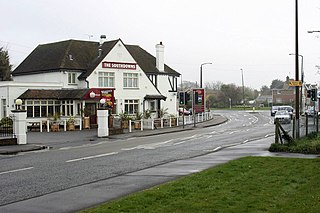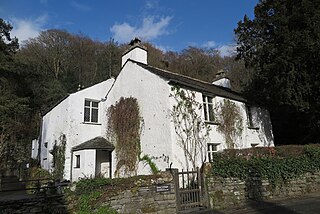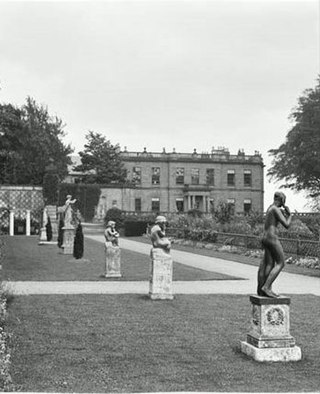
"And did those feet in ancient time" is a poem by William Blake from the preface to his epic Milton: A Poem in Two Books, one of a collection of writings known as the Prophetic Books. The date of 1804 on the title page is probably when the plates were begun, but the poem was printed c. 1808. Today it is best known as the hymn "Jerusalem", with music written by Sir Hubert Parry in 1916. The famous orchestration was written by Sir Edward Elgar. It is not to be confused with another poem, much longer and larger in scope and also by Blake, called Jerusalem The Emanation of the Giant Albion.

William Blake was an English poet, painter, and printmaker. Largely unrecognised during his life, Blake is now considered a seminal figure in the history of the poetry and visual art of the Romantic Age. What he called his "prophetic works" were said by 20th-century critic Northrop Frye to form "what is in proportion to its merits the least read body of poetry in the English language". His visual artistry led 21st-century critic Jonathan Jones to proclaim him "far and away the greatest artist Britain has ever produced". In 2002, Blake was placed at number 38 in the BBC's poll of the 100 Greatest Britons. While he lived in London his entire life, except for three years spent in Felpham, he produced a diverse and symbolically rich collection of works, which embraced the imagination as "the body of God" or "human existence itself".
This article contains information about the literary events and publications of 1800.

William Hayley was an English writer, best known as the biographer of his friend William Cowper.

Alfriston Clergy House in Alfriston, Polegate, East Sussex, England, was the first built property to be acquired by the National Trust. It was purchased in 1896 for £10. The house lies adjacent to the Church of St. Andrew. It is a Grade II* listed building. The house is open to the public.
The Landmark Trust is a British building conservation charity, founded in 1965 by Sir John and Lady Smith, that rescues buildings of historic interest or architectural merit and then makes them available for holiday rental. The Trust's headquarters is at Shottesbrooke in Berkshire.

Milton is an epic poem by William Blake, written and illustrated between 1804 and 1810. Its hero is John Milton, who returns from Heaven and unites with Blake to explore the relationship between living writers and their predecessors, and to undergo a mystical journey to correct his own spiritual errors.

Felpham is a village and civil parish in the Arun District of West Sussex, England. Although sometimes considered part of the urban area of greater Bognor Regis, it is a village and civil parish in its own right, having an area of 4.26 km2 with a population of 9,611 people that is still growing. The population at the 2011 Census was 9,746.

Jerusalem, subtitled The Emanation of the Giant Albion, is a prophetic book by English poet William Blake. Jerusalem is the last, longest and greatest in scope of Blake's works. Etched in handwriting, accompanied by small sketches, marginal figures and huge full-plate illustrations, it has been described as "visionary theatre". The poet himself believed it was his masterpiece and it has been said that "of all Blake's illuminated epics, this is by far the most public and accessible". Nonetheless, only six copies were printed in Blake's lifetime and the book, like all of Blake's prophetic works, was all but ignored by his contemporaries.

Edensor is a village and civil parish in Derbyshire, England. The population of the civil parish at the 2011 census was 145.

Middleton-on-Sea is a village, civil parish and an electoral ward in the Arun District of West Sussex, England, lying to the east of Bognor Regis and neighbouring Felpham. The parish also contains the settlements of Elmer and Ancton. The southern half is urban and the northern rural.

Dove Cottage is a house on the edge of Grasmere in the Lake District of England. It is best known as the home of the poet William Wordsworth and his sister Dorothy Wordsworth from December 1799 to May 1808, where they spent over eight years of "plain living, but high thinking". During this period, William wrote much of the poetry for which he is remembered today, including his "Ode: Intimations of Immortality", "Ode to Duty", "My Heart Leaps Up" and "I Wandered Lonely as a Cloud", together with parts of his autobiographical epic, The Prelude.
Nationality words link to articles with information on the nation's poetry or literature.

Calverley Old Hall is a medieval manor house with Grade I listed building status situated at Calverley, West Yorkshire, England.

Tisman's Common is a hamlet in the Horsham District of West Sussex, England. It stands in the parish of Rudgwick, on the Rudgwick to Loxwood road, 6.4 miles (10.2 km) west of Horsham.

Windlestone Hall is a mid-16th century Elizabethan country house, heavily rebuilt in 1821 to form a Greek revival stately home, situated near Rushyford, County Durham, England. It is a Grade II* Listed building. As of 2022 it is back in private family ownership, with the surrounding estate maintained and conserved by a dedicated heritage charitable trust.

The Cowper and Newton Museum is a museum in Olney, Buckinghamshire, England, in the City of Milton Keynes. Celebrating the work and lives of two famous local residents: William Cowper (1731–1800), a celebrated 18th-century poet; and John Newton (1725–1807), a prominent slave trader who was curate in the local church. Together, Cowper and Newton wrote the Olney Hymns, including one of the world's most popular hymns, "Amazing Grace".

The Notebook of William Blake was used by William Blake as a commonplace book from c. 1787 to 1818.

Sandycombe Lodge is a Grade II* listed house at 40 Sandycoombe Road, Twickenham, in the London Borough of Richmond upon Thames. In the picturesque-cottage style, it was designed and built in 1813 by the artist J. M. W. Turner (1775–1851) as his country retreat and as a home for his father William (1745–1829). Turner lived there from 1814 to 1826. Originally known as Solus Lodge, it is the only surviving building designed by Turner, and shows the influence of his friend Sir John Soane. The appearance of the house had been much altered by the addition of second floors to the original side wings.

3, The Grove, Highgate, in the London Borough of Camden, is a 17th-century house built by William Blake. In the 19th century it was home of the poet Samuel Taylor Coleridge; in the 20th, the novelist J. B. Priestley; and in the 21st, the model Kate Moss. It is a Grade II* listed building.


















